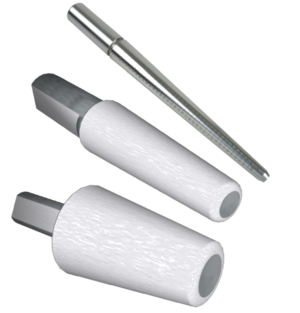Triblet: Difference between revisions
From DT Online
(Created article) |
mNo edit summary |
||
| (One intermediate revision by the same user not shown) | |||
| Line 2: | Line 2: | ||
=====Description===== | =====Description===== | ||
'''Stakes''' are available in a wide variety of shapes and sizes. They are usually made of [https://en.wikipedia.org/wiki/Cast_iron#Malleable_cast_iron '''Cast Iron'''] but '''Triblets''' | '''Stakes''' are available in a wide variety of shapes and sizes. They are usually made of [https://en.wikipedia.org/wiki/Cast_iron#Malleable_cast_iron '''Cast Iron'''] but '''Triblets''', '''[[Mandrel Stake|Mandrel Stakes]]''' and some '''[[Planishing Stake|Planishing Stakes]]''' for example can be self-made from [https://en.wikipedia.org/wiki/Carbon_steel#Mild_steel '''Mild Steel''']. | ||
| Line 14: | Line 14: | ||
[[Category:Stakes]] | [[Category:Stakes]] | ||
[[Category:Beaten Metalwork]] | |||
Latest revision as of 12:57, 22 May 2017
Description
Stakes are available in a wide variety of shapes and sizes. They are usually made of Cast Iron but Triblets, Mandrel Stakes and some Planishing Stakes for example can be self-made from Mild Steel.
Tapered Mandrel Stakes are also known as Triblets. They are useful for forming and Planishing cone shaped objects. Very slim Triblets are known as Ring Triblets and are used for truing and sizing rings to suit different sized fingers - they are often marked with graduations which indicate the finished ring diameter.
- 12oz Hammers (0.45kg) are a good useful size for general work in Design and Technology.
- Larger 2lb hammers (1kg) are used for heavier work such as Blacksmithing for example.
- Smaller hammers (e.g. 4oz and 8oz) are suitable for jewellery work and model engineering applications.
- Brick Hammers between 1lb and 1.5lb weight (450g to 700g) are suitable for school use and are available also with a Scutch Comb Chisel at one end which can be used for shaping brick and masonry.
- A 2lb Lump Hammer (0.9kg) is a good useful size for general work in Design and Technology and home maintenance tasks.
- 2lb to 4lb Sledge Hammers (1-2kg) are a suitable size for general forge-work in Design and Technology since hammers heavier than 4lb would be difficult for students to use.
 |
 |
 |
 |
 |
 |
 |
 |
| Ball Pein Hammer |
Blacksmiths Hammers |
Brick Hammer |
Claw Hammer |
Cross Pein Hammer |
Lump (or Club) Hammer |
Pin Hammer |
Sledge Hammer |
- Traditional Boxwood Mallets are now largely superceded by Nylon, PVC or rubber faced hammers and mallets for general work. They are available in a range of diameters and weights.
- Carpenters' Mallets with a head size of 4-5 inches (100mm - 125mm) are a suitable size for most work in Design and Technology.
- Carving Mallet heads are commonly made from Beech but Lignum Vitea heads are considered better because they are heavier. They may now be hard to find. A modern alternative is to use Polyurethane for the heads (Bronze or Brass also used). A good general size head weight for light work would be approximately 450 grams or less, and for general work, 800 grams is more suitable.
- Bossing Mallets are sized by head diameter (35, 50, 60, or 75mm). The smaller sizes are used for art metalwork and the larger sizes are for shaping and stretching sheet metal and soft roofing materials such as lead.
 |
 |
 |
 |
 |
| Nylon Hammer |
Rubber Mallet |
Carpenters Mallet |
Carvers Mallet |
Rawhide Mallet |
